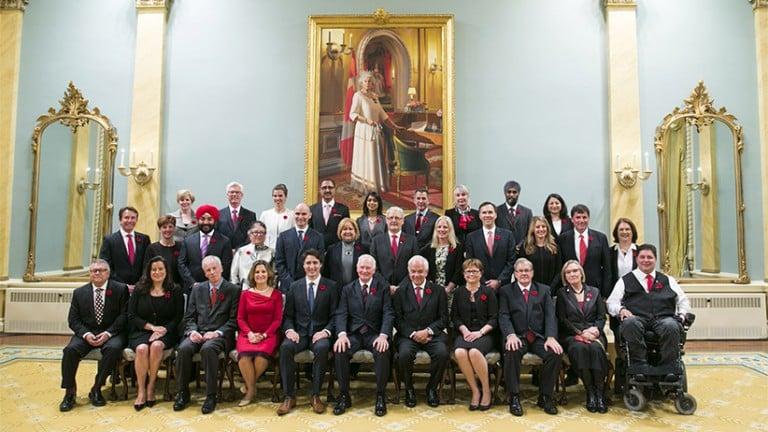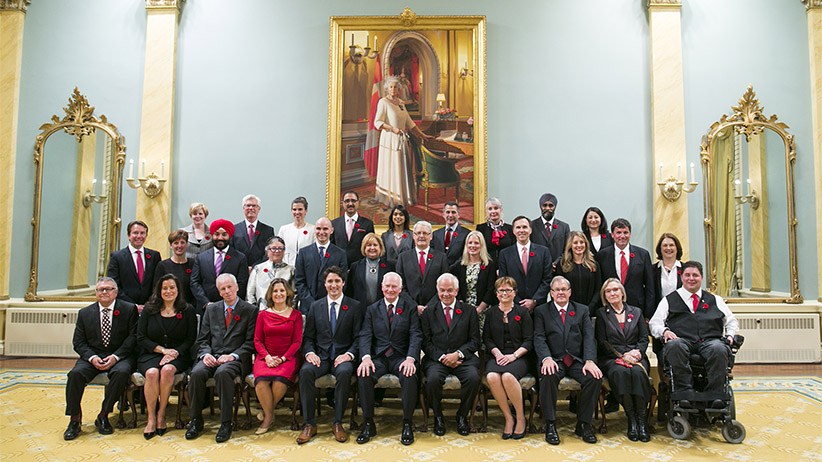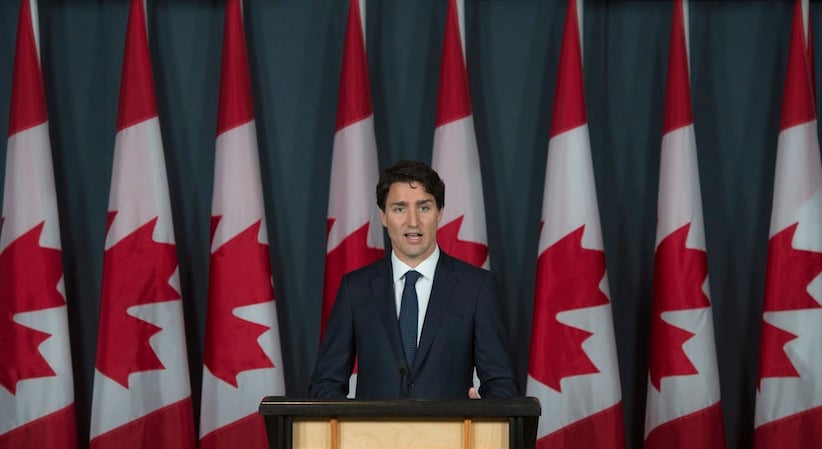The Liberals killed a bill promoting gender parity in politics. They were wrong.
Why the arguments against a bill that would have penalized parties for failing to run equal lists of male and female candidates don’t make sense

Newly elected Canadian Prime Minister Justin Trudeau, fifth left first row, takes a group photo with his cabinet ministers at Rideau Hall in Ottawa, Canada, Nov. 4, 2015. Justin Trudeau was sworn in as Canada’s 23rd prime minister and named a 31-member cabinet here Wednesday. (Chris Roussakis/Xinhua News Agency/Getty Images)
Share

Justin Trudeau got a lot of credit for appointing a gender-balanced cabinet when his government was elected one year ago. But last week, the Liberals rejected a private member’s bill that aimed to further the progress of women in politics.
The bill would have financially penalized political parties that didn’t run nearly equal lists of male and female candidates, providing incentive to seek out more balance at the riding level. The government refused to back the proposed law on constitutional grounds and because it would unfairly penalize small parties. But independent experts, including the House of Commons’ own lawyer, say the government’s objections don’t hold water.
Bill C-237 was killed off last week by a vote of 209-68, meeting the typical fate of private members’ bills. In the free vote, no Conservative voted in favour of the bill, and no NDP member voted against it. Twenty-three Liberal backbenchers voted for the bill, against the advice of their party’s leadership. “You might call it a backbench revolt, to some extent,” says Kennedy Stewart, the NDP MP for Burnaby South who introduced the bill in the spring. “Even the Conservatives who sat next to me said, ‘Wow, you got 23, that’s pretty good.’ ”
Stewart’s proposal was to leverage the share of campaign expenses that parties get back from Elections Canada after elections. They are now eligible for up to 50 per cent reimbursement, if they get at least two per cent of the votes cast nationally or five per cent in ridings where they fielded candidates. Under Stewart’s formula, they would get less depending on how many more men they ran than women.
So in the 2015 election, for example, the Conservatives, with 20 per cent women candidates, would have been penalized $2.3 million; the Liberals, with 31 per cent women, would have given up $1.5 million; the NDP, with 43 per cent women, would have forfeited $148,700; and the Green Party—with 39 per cent women—would have lost $58,600.
But beyond the financial cost, this bill posed an optics problem for a government that made headlines a year ago for its much-vaunted parity cabinet, says Erin Crandall, an assistant professor of political science at Acadia University. “A bill like this obviously puts the Liberal government in an awkward position,” she says. “If the party was confident that it could easily meet the 45 per cent threshold for the next election, I believe it would have supported the bill.”
In a briefing note to government MPs leaked when the bill was introduced in May, Liberals were advised to oppose it. The “most significant issue,” in the government’s rationale, was the unfair impact on small political parties, since those running only a few candidates might have trouble achieving gender balance. In practical terms, though, that doesn’t matter. In 2015, only the four national parties and the Bloc Québécois qualified for any reimbursements at all. No smaller niche parties even came close to the threshold, so they couldn’t be penalized. Yet the government is sticking to this argument. “While this did not occur in the last general election,” an official for Democratic Institutions Minister Maryam Monsef told Maclean’s, “it is possible.”

The Liberals also argue that with electoral reform on the immediate horizon, it doesn’t make sense to enact gender-parity measures based on the current voting system. However, in an Oct. 19 interview with Le Devoir, Prime Minister Justin Trudeau appeared to back away from his government’s promise that the 2015 election would be the last under the first-past-the-post system. He told the Quebec paper that citizens were so displeased with Stephen Harper’s government that the public will was there for electoral reform, but that imperative has now faded with the electorate more content. The Prime Minister has since insisted he remains “deeply committed” to electoral reform, and Monsef’s office says the government is focused on “modernizing our voting system to be more inclusive and reflective of Canadians’ needs and aspirations.”
At the same time, however, the Liberals argue that there is no example of a gender-parity law that has been effective in a jurisdiction that uses Canada’s current electoral system. In 2000, France instituted a similar measure to what C-237 proposes. At first, political parties simply paid the fine and ignored the requirement to run more female candidates. But eventually, it became politically unpopular to do so, and France went from 11 per cent women representatives in 1999 to 26.2 per cent currently. Ireland enacted a similar law in 2012, and in 2015—the first general election after the law came into effect—the percentage of women in the legislature reached 22.2 per cent, up from 15.1 per cent in the previous election. In spite of those successes, the Canadian government argues it’s impossible to assess how this might work in Canada, under a voting system the Liberals have pledged to replace. “It remains difficult to find any established first-past-the-post country which uses a legislated gender quota system,” the government says.
Perhaps most substantial among the Liberals’ stated objections to C-237 were a host of potential problems with respect to the Charter of Rights and Freedoms. Stewart requested an opinion from House of Commons legislative counsel, which walked through three relevant sections of the Charter and concluded the bill posed no problems for any of them. Parliamentary lawyers concluded the bill could in fact be considered an affirmative action measure—something protected by the Charter—because it “strives to promote consideration of a disadvantaged group—women—in politics and public life.”
Kerri Froc, a postdoctoral fellow in the department of law at Carleton University, where she specializes in gender rights under the Charter, assessed each of the government’s constitutional objections to the bill at the request of Maclean’s. The government argued, for example, the proposed law could create problems under Section 3 of the Charter, which ensures the right to be qualified for membership in the House of Commons, but Froc says the “obvious answer” is this law would do nothing to impede that: parties could run whomever they want; they would just have to pay a fine if their slates were lopsided in gender.
And on a deeper level, Froc says a Section 3 challenge is a non-starter because the point of the bill is to correct an existing disadvantage for women. “To the extent that men would be seeking to use Section 3 so that they can continue to receive party nominations in disproportionate numbers—to allow systemic bias in their favour to continue—this is essentially asking for the court to allow their Section 3 rights to continue to ‘count more,’ ” she says.
Froc describes another of the government’s contentions—that the bill could infringe on people’s right to association—as “on fairly thin ice,” because there’s nothing to suggest a male candidate would be prevented from joining with others to promote a common goal. And concerns that the bill could interfere with freedom of expression if— as the government suggests—someone wanted to start an all-female party, is “far-fetched,” she says. “There might come a day where an all-woman party is formed, runs a slate of all female candidates, and then constitutionally challenges legislation meant to benefit women, but not in my lifetime,” Froc said.
“I don’t regard any of the concerns as fatal to the bill, as having sufficient merit to warrant the government blocking the bill,” she concluded. “If the government truly believes ‘it’s 2016,’ then it should get on with it and use the tools at its disposal to remove systemic barriers to women’s equal electoral participation.”
In fact, Froc suggests there could be grounds for a constitutional case on the other side of the issue: women could bring Charter challenges against the current party nomination process that systemically favours men. “Study after study has shown that the party nomination process is where the problem is—the electorate doesn’t discriminate against female candidates. The choice is not between do nothing and status quo, or pass the bill and face a Charter challenge,” she says.
Melanee Thomas, an assistant professor of political science who specializes in gender and politics at the University of Calgary, says it’s a “feeble argument” that a measure like C-237 would restrict anyone from running. She argues that long-standing requirements for federal candidates—including a $1,000 deposit and the party leader signing off on each nominee—pose a bigger barrier than the financial imperative to run gender-balanced slates. “This tells parties that they need to smarten up,” she says. “This doesn’t tell any Canadian that they can’t be on a ballot.”
The Liberals were the only party that in 2015 nominated a larger proportion of women (31 per cent) than they got elected (27 per cent), suggesting female candidates were disproportionately nominated in races they couldn’t win, Thomas says—particularly given that the Liberals cruised to victory in many ridings they weren’t expected to take. To advance weak Charter arguments against a measure aimed at improving the involvement of women in politics while talking so much about feminism makes the Liberal commitment to equality look like “a veneer,” Thomas says. “There’s a big talk on diversity, and the action is really underwhelming,” she says. “And in this case, I would say it’s insulting.”
Gestures like Trudeau’s gender-balanced cabinet easily backslide if the system isn’t changed in real ways, Thomas says; Jean Charest’s gender-parity cabinet in Quebec in 2007, after all, was a one-off. “The symbolic stuff at the top doesn’t matter unless it’s carried all the way to the bottom. So this is telling me that this particular bunch of leaders aren’t actually committed to seeing this through,” she says. “A real feminist would say, ‘Yeah, sure, we can do this at the top, but we’ve got to make sure this is an institutional norm so that when we’re no longer here, the expectation stays.’ ”